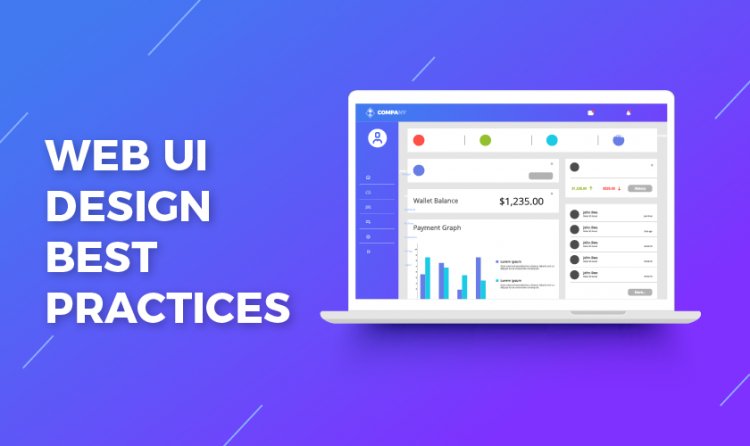
TABLE OF CONTENTS
UI Design Principles and Best Practices
User Interface Design is important as it can make or break your base of customers. This causes fewer challenges, improves user experience, perfects functionality, and provides a good bond between your clients and your website. Today, we discuss UI design principles and best practices.
What are UI Designs?
User interface ( UI) design is used by process designers to create software or computerized system interfaces with an emphasis on looks or style. Designers are aiming to create interfaces that users find easy and pleasurable to use. UI design applies to graphical user interfaces and other forms — e.g., interfaces powered by speech.
UI Design Guidelines
User Interface ( UI) design guidelines focus on predicting what users will need to do, and ensuring that the interface has elements that are easy to navigate, understand, and use to promote such acts. UI brings together concepts relating to interaction design, visual design, and architecture of information.
Choosing Interface Elements
Users are familiar with the interface elements that function in some way, so strive to be consistent and straightforward with your choices and layout. Doing so will help fulfillment, efficiency, and satisfaction of tasks.
Interface elements include but are not limited to:
- Input Controls: buttons, text fields, checkboxes, radio buttons, dropdown lists, list boxes, toggles, date field
- Navigational Components: breadcrumb, slider, search field, pagination, slider, tags, icons
- Informational Components: tooltips, icons, progress bar, notifications, message boxes, modal windows
- Containers: accordion
There are occasions when multiple elements may be suitable to view content. When this happens, the consideration of the trade-offs is important. For example, sometimes elements that can help you save space, mentally put more of a burden on the user by forcing them to guess what’s inside the dropdown, or what the element might be.
Web UI Design Best Practices
Now, we discuss web UI design practices. The UI design best practices for better scannability are listed below:
Keep the Easy Interface.
For the user, the best interfaces are almost invisible. They avoid needless elements and the terminology they use on labels and in messaging is simple.
Improve consistency and employ rising elements of the UI.
Using common elements in your UI will make users feel more comfortable and be able to get things done faster. Creating patterns in language, layout, and design across the site is also essential to help promote performance. Once a user learns how to do something, that skill should be transferred to other parts of the site.
Be purposeful in page layout.
Consider the importance-based spatial relationships between items on the page and structure the page. Careful positioning of items can help to draw attention to the most important pieces of information, which may help to search which read.
Using color and texture Strategically.
To your advantage, you can focus attention on or redirect attention away from items by using color, light, contrast, and texture.
To build Hierarchy and Clarity, using typography.
Consider carefully the way you use the typeface. Various sizes, fonts, and text arrangement to help improve scanability, legibility, and readability.
Please make sure the device understands what is going on.
Always keep your users informed about the location, actions, state changes, or errors. Using different UI elements to communicate status, and the following steps will minimize annoyance for your user if appropriate.
Think about the defaults.
By carefully considering and anticipating the goals people bring to your site, you can create defaults that reduce the user’s burden. This becomes especially important when it comes to forming design where you may have an opportunity to have certain fields pre-selected or filled out.

UI Design Fundamentals
Here are all the UI design fundamentals that you need:
1. Define your user
You aim to provide value to your consumer and fulfill a need. Keep the user and his / her needs in mind at all times during the user interface design process. Consider what interfaces they want, inspire them by features, typography, styles, and what calls to behavior. Observing how such interfaces are used will give you invaluable insight. Focusing on your user first helps you to create an engaging interface that will lead them to the end goal.
2. Familiar UI patterns
The wheel no need to be reinvented. What interfaces do the users spend most of their time on? Using the use of common applications, such as Twitter, Instagram, Google, and Gmail as examples of UI design to help solve specific interface problems. Users will appreciate the familiarity of those UI patterns and their simplicity.
3. Effective communication and feedback
Without a doubt, familiar UI patterns will step up the UI design game, but even the most common UI patterns are not foolproof. Think of your interface as in conversation with your user. Communicating with the user after any activity would go a long way by offering regular feedback validating their behaviors and nudging them along.
4. Stay consistent
Consistency is what it takes! When a consumer knows and learns how to do it, next time they will be able to do it more efficiently and effortlessly. All should remain the same throughout, including language, layout, color scheme, navigation buttons, menus, and every other design feature. Such little information can keep the user at work and remove unwanted distractions.
Best Practices for UI Development
Here are some points of the best practices for UI development:
- Cater to Universal Usability.
- Clarity. …
- Prevent Errors. …
- Make the Interface Consistent. …
- Context. …
- Size and Distance. …
- Defaults. …
- Guided Actions.
How to Improve UI Design?
I have listed down some steps of how to improve UI design:
- Get to grips with UI design patterns.
- Train your eye.
- Get networking.
- Copy top designers.
- Take on imaginary projects.
- Share your work (and ask for feedback)
- Find a mentor.











let’s get started!
Get in touch today. We’re ready!